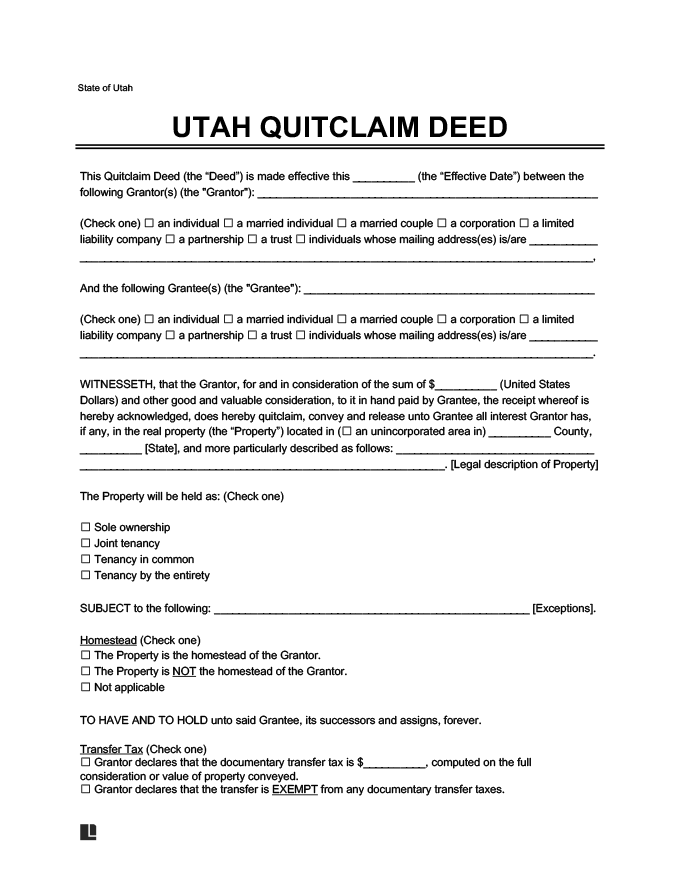The primary purpose of quitclaim deeds in Utah is to convey or edit real estate property ownership without guaranteeing a lack of liens or encumbrances. These deeds do not typically involve a significant money transfer, making them ideal for more informal transactions. Review the state’s requirements for executing this deed below to ensure your document is enforceable.
Legal Framework
Utah Code § 57-1-13 provides the statutory form for quitclaim deeds. It implements the word “quitclaim” for clarity. It includes the main property and associated structures, features, privileges, and rights that belong to the property. Please note that it doesn’t guarantee the quality of ownership or the lack of liens.
If a boundary line agreement operates as a quitclaim deed, it must meet the requirements in Utah Code § 10-9a-524 or Utah Code § 17-27a-523 (whichever is applicable).
Legal Description
Utah Code § 57-3-105 requires a legal description to accompany legal documents, including a quitclaim deed. The statute says that the legal description can consist of any of the following:
- Metes and bounds.
- A governmental survey that either (a) references the Public Land Survey System or (b) specifies the real property’s township, base, range, and meridian.
- A lot, block, tract, parcel, or unit within a previously recorded plat or map.
- The claim name and the state/federal agency serial number (if available) if the real property consists of a mining claim.
Signing
Under Utah Code § 57-3-101, a notary must witness the grantor’s signature. The quitclaim deed will not be valid for filing without a notary seal.
Additional Documents
Utah Code § 57-3-109 requires the grantor to submit a Water Rights Addendum with their quitclaim deed. The addendum should clearly outline the transfer of water rights on the property. Even if the transfer doesn’t involve water rights, the grantor must still fill out this additional document and clarify that no water rights pertain to the transfer.
Filing
Per Utah Code § 57-3-101, the grantor must record their quitclaim deed with the local County Recorder’s Office in the county where the property exists.
Validity Requirements
For the county recorder’s office to deem a quitclaim deed valid, it must meet the following requirements (Utah Code 17-21-20):
- Be an original document or a certified copy of the original document.
- Be in English or have an accurate English translation.
- Have a visible and legible notary seal.
- Have original signatures.
- Be on white paper that’s 8.5 inches by 11 inches.
- Not be on sheets of paper that are bound together.
- Not contain printed material on both sides of the pages.
- Have a space of 4.5 inches across and 2.5 inches down the upper right corner of the first page and a one-inch margin at the top of each subsequent page.
- Be legible enough to make certified copies.
- Be printed in black ink.
- Have text that’s no smaller than seven lines of text per vertical inch.
Content Requirements
Here are the requirements for the content within your quitclaim deed:
- The grantor’s and grantee’s full legal names.
- The grantor’s and grantee’s addresses.
- The consideration the grantee will provide to the grantor (if applicable).
- The property’s legal description (the description must match the one in the previous deed to the property on file with the county recorder).
- The agreement’s date.
Quitclaim Deeds vs. Other Property Transfer Methods
| Quitclaim Deed | Conveys whatever interest or claim the grantor may have in the property to the grantee without any assurances about the title. |
| General Warranty Deed | Transfers property with a guarantee that the grantor holds a clear title to the property and has the right to sell it (Utah Code § 57-1-12). |
| Special Warranty Deed | Similar to a general warranty deed but with limitations on the warranties that the grantor provides. Usually, the grantor only guarantees against title claims that occurred during their ownership (Utah Code § 57-1-12.5). |
| Grant Deed | Similar to a special warranty deed but has fewer protections for the grantee. |
| Transfer on Death Deed | Lets property owners designate beneficiaries who will immediately inherit the property upon their death (Utah Code § 75-6-416). |
